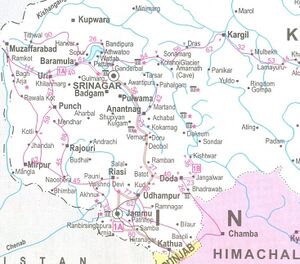Nandikshetra
| Author:Laxman Burdak, IFS (Retd.) |

Nandikshetra (नंदीक्षेत्र) was an ancient shrine of Shiva mentioned in Rajatarangini. [1] It lies in Ganderbal district of Jammu and Kashmir.
Location
Twenty-three miles south of Srinagar in Kashmir near the Haramukh mount, including the Gangābal lake and the sacred lake called Nandisara or Nandkol or Kālo daka which is said to be the residence of Shiva and his faithful attendant Nandin. [2]
History
Harmukh mountain (हरमुख पर्वत) is a mountain with a peak elevation of 5,142 metres, in Ganderbal district of Jammu and Kashmir. Harmukh is part of the Himalaya Range, and is located between Nallah Sindh in the south and Kishanganga Neelum River in the north, rising above Gangabal Lake [3] in the vicinity of Kashmir valley. It is mostly climbed from the northwestern side of Arin- Bandipore. Harmukh, with Gangbal Lake at its foot, is considered a sacred mountain by Hindus. According to kashmiri hindu theology, Harmukh is the abode of Lord Shiva.[4][5]
Gangabal Lake (गंगाबल झील) is situated at the foothills of Mount Haramukh (the highest mountain peak in the vicinity of Kashmir valley) in Ganderbal district, north of Srinagar city in Jammu and Kashmir, India. The lake has a maximum length of two and a half kilometres and maximum width of one kilometre. It is fed by precipitation, glaciers and springs. The lake water outflows to a nearby Nundkol Lake and then via Wangath nallah to Sind River.[6] The Gangabal lake is approached from Srinagar 45 kms by road via Ganderbal up to Naranag and then a trek of 15 kms upslopes leads to the lake, which can be covered by a horse ride or by foot. Another trek (25 kms long) leads to the lake site from Sonamarg via the Vishansar Lake crossing three mountain passes Nichnai pass, Gadsar pass and Zajibal pass of an average elevation of 4100 meteres. It can also be accessed through a trek from Bandipore via Arin.
In Rajatarangini
Rajatarangini[7] tells that....The shrine of Nandi Kshetra where the spots of sandal, with which the gods performed worship, are visible to the present day. There, at Nandi, is also Sarada, or Durga, by seeing whom one gains immediate salvation and the gift of the flowing and sweet speech of a poet. (Book I, p.4)
Rajatarangini[8] tells that....At Nandikshetra Jaloka son of Ashoka caused a house of Shiva Bhutesha to be erected and bestowed much wealth on it. It seems his last days were spent in devotion. (Rajatarangini of Kalhana:Kings of Kashmira/Book I,p.11)
Rajatarangini[9] tells that ....Rising from his sleep, King Sandhimati performed his morning devotions and re-paired to the celebrated shrine of Sodara. There in Nandikshetra he stood before the image of Mahadeva besmeared with ashes, his locks of hair tied, his hand holding a garland of seeds, while the old rishis looked on him with surprise. He spent his days in devotions and begging alms. (Book II, p.35)
[Rajatarangini]][10] mentions ....At Nandikshetra Ratnadevi, queen of Jayasimha (1128 - 1149 AD) of second Lohara dynasty, had raised religious schools, and in the principal places of the Yavanas she had built delightful mathas. Book VIII (i), p.218
Uchchala re-built Nandikshetra
Rajatarangini[11] tells us that Uchchala re-built Nandikshetra which had been burnt by a destructive fire, and made it more beautiful than it was before. The king who was bent on repairing the dilapidated buildings repaired Shrichakradhara, Yogesha and Svayambhu. He set up anew at Parihasapura, the god Shriparihasakeshava which king Harsha had taken away. He was devoid of cupidity and adorned Tribhuvanasvami with the Shukavali, described before, which had also been taken out by king Harsha. He also renewed the most beautiful throne in his kingdom, the same that was brought by Jayapira but had been burnt by fire during the revolution which led to Harsha's dethronement.
References
- ↑ Book I (p.4), Book II (p.35), Book VII (p.216, 240); Book VIII(p.8); Book VIII (i) (p.218).
- ↑ Encyclopaedia of Ancient Indian Geography, Volume 2, Subodh Kapoor, p.489
- ↑ Geography of Jammu & Kashmir State by Dr. A. N. Raina:Rivers, Lakes, Springs, Tributaries and Glaciers
- ↑ "Gangabal Harmukh pilgrimage". searchkashmir.org.
- ↑ [6]
- ↑ Raina, Maharaj Krishen. "Know Your Motherland – Gangabal Lake".
- ↑ Book I (p.4)
- ↑ Rajatarangini of Kalhana:Kings of Kashmira/Book I,p.11
- ↑ Rajatarangini of Kalhana:Kings of Kashmira/Book II,p.35
- ↑ Kings of Kashmira Vol 2 (Rajatarangini of Kalhana)/Book VIII (i), p.218
- ↑ Kings of Kashmira Vol 2 (Rajatarangini of Kalhana)/Book VIII, p.8